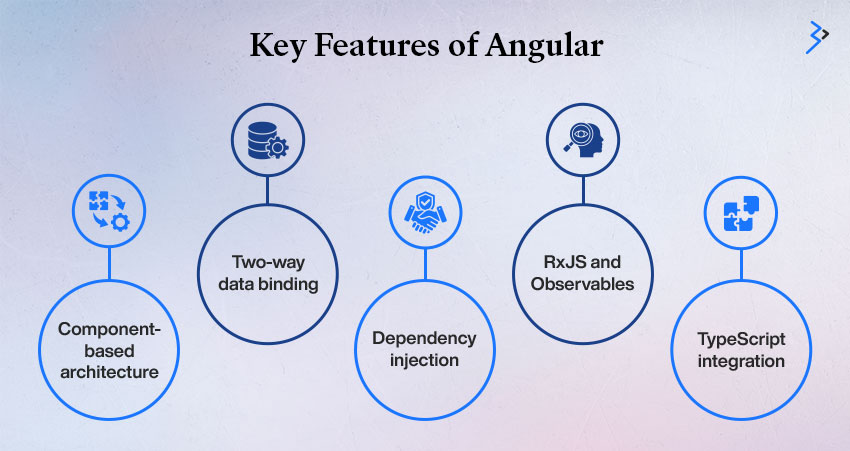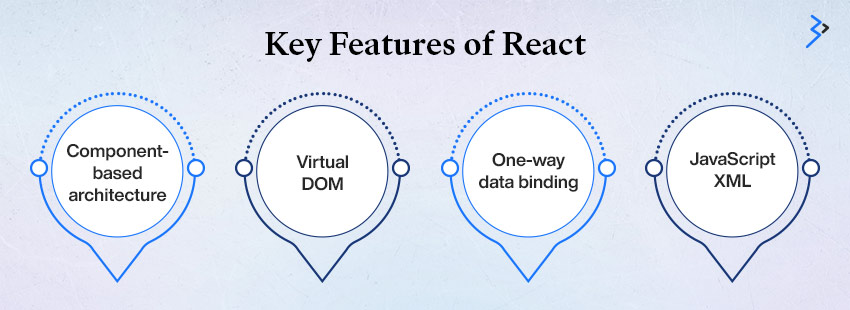Table of contents
What is Angular?
What is React?
Framework vs. Library: Core Differences
Angular vs. React: A Quick Comparison
React JS vs Angular: When to Choose What?
Angular and React are two of the most popular front-end technologies for building modern, feature-rich web applications in the developer world. Each brings unique strengths and capabilities, making it essential to understand their differences before deciding which one to use for your next project.
Choosing between Angular and React can be complicated. Both are competent tools for creating complex user interfaces, but the right choice depends on several factors: project scope, learning curve, development time, and overall flexibility.
This article compares Angular and React's features, strengths, and limitations. By the end, you'll have a clearer picture of which technology best meets your development needs.
Understanding Angular and React
Before comparing the two, let's break down what Angular and React are, their origins, and their key attributes.
What is Angular?
Google introduced Angular in 2010. It is a TypeScript-based open-source JavaScript framework designed to build single-page applications (SPAs) and interactive web interfaces. Angular's robust architecture and built-in tools make it a comprehensive framework that simplifies development for large-scale, dynamic projects. Many businesses leverage AngularJS development services to create scalable and high-performing web applications.
A Brief History:
Angular was initially launched as AngularJS, a JavaScript-based framework. While AngularJS revolutionized front-end development, it struggled to meet modern requirements, especially for large-scale projects. In 2016, Google introduced Angular 2 (called "Angular"), a complete rewrite using TypeScript.
Angular's primary goal is to offer a full-fledged framework that includes everything developers need: routing, state management, templates, and testing tools.
Key Features of Angular:

- Component-based architecture: Angular structures applications using components, which are modular, reusable building blocks.
- Two-way data binding: Angular synchronizes data between the model and view, ensuring seamless updates across the application.
- Dependency injection: This design pattern simplifies code structure, enhances modularity, and improves testability.
- RxJS and Observables: Angular uses RxJS (Reactive Extensions for JavaScript) to handle asynchronous events, making it easier to manage data streams.
- TypeScript integration: Angular leverages TypeScript, offering benefits like static typing, better tooling, and easier debugging.
Read More: Angular Vs ReactJs: Which is the Best for Your Project?
Strengths of Angular:
- It is ideal for enterprise-grade applications due to its comprehensive framework.
- Built-in tools like Angular CLI make project setup and development efficient.
- Native TypeScript support ensures clean, maintainable code.
- Two-way data binding enables real-time synchronization between the view and the model.
What is React?
React, developed and open-sourced by Facebook in 2013, is a lightweight JavaScript library that builds fast and interactive user interfaces. Unlike Angular, React isn't a full-fledged framework. Instead, it concentrates on the "View" layer of applications, providing flexibility to integrate additional libraries as needed. Many businesses partner with a Top React JS Development Company to leverage React’s flexibility and performance for scalable web applications.
A Brief History:
React emerged as a solution to Facebook's internal need for dynamic and performant user interfaces. React quickly gained popularity by introducing a component-based architecture and virtual DOM and became a game-changer in front-end development. Its "Learn Once, Write Anywhere" principle allows developers to create reusable components for both web and mobile applications.
Key Features of React:

- Component-based architecture: React introduced the concept of building UIs as reusable components, promoting modularity and reusability.
- Virtual DOM: React uses a virtual representation of the DOM, improving performance by updating only the components that change.
- One-way data binding: React enforces unidirectional data flow, simplifying state management and debugging.
- JSX (JavaScript XML): React combines JavaScript and HTML in JSX, enabling developers to write markup within JavaScript logic.
Strengths of React:
- Lightweight and flexible, offering developers more freedom in choosing libraries and tools.
- Virtual DOM enhances performance by reducing unnecessary updates to the real DOM.
- Component reusability accelerates development time and reduces redundancy.
- Strong community support and widespread adoption ensure constant innovation and resources.
Read More: React vs. Angular – Select The Best for Mobile App Development
Framework vs. Library: Core Differences
At their core, Angular and React differ significantly in their design philosophy and approach. Angular is a complete framework, whereas React functions as a library.
Angular: The Full-Fledged Framework
Angular offers a complete ecosystem, meaning you get all the tools required for front-end development, including:
- Built-in routing
- Form validation
- State management
- HTTP client
With Angular, there's little need for additional libraries, as most features are available out of the box. This makes Angular ideal for large-scale applications where consistency and scalability are priorities.
React: The Lightweight Library
React's focus is solely on UI development. To build a complete application, developers often need to integrate third-party libraries for tasks like:
- Routing (e.g., React Router)
- State management (e.g., Redux or Context API)
- HTTP requests (e.g., Axios or Fetch API)
While this flexibility allows for tailored solutions, it requires additional decision-making and setup.
Data Binding: Two-Way vs. One-Way
Data binding is another significant distinction between Angular and React.
Angular's two-way data binding ensures real-time synchronization between the model and the view. If a user modifies an input field, the underlying data model updates automatically, and vice versa.
Example: If a user types into an input box, Angular immediately reflects the change in the corresponding component property.
While this approach simplifies data handling, it can impact performance in complex applications since each binding requires a watcher to track changes.
React: One-Way Data Binding
React follows a one-way (unidirectional) data-binding approach, where data flows from the component's state to the view. Changes in the view don't directly impact the component's state without explicit instructions.
Example: To update an input field in React, developers use controlled components and explicitly call setState() or hooks like useState().
This one-way approach simplifies debugging and improves performance but requires slightly more effort to set up.
DOM Manipulation: Real DOM vs. Virtual DOM

Both Angular and React manipulate the DOM to update the user interface, but they use different approaches:
-
Angular: Real DOM
Angular operates on the real DOM, meaning it updates the entire tree structure when a change occurs. While this can be resource-intensive, Angular mitigates the performance hit using change detection to identify and update only the necessary components.
-
React: Virtual DOM
React uses a virtual DOM, a lightweight copy of the real DOM. When a change occurs, React compares the virtual DOM with the real DOM (a process called "diffing") and updates only the modified components.
This approach significantly improves performance, especially in applications with frequent UI updates.
Language and Syntax: TypeScript vs. JSX

-
Angular: TypeScript
Angular uses TypeScript, a superset of JavaScript that adds static typing. TypeScript helps developers catch errors early, enhances code navigation, and improves maintainability for large projects.
-
React: JavaScript + JSX
React primarily uses JavaScript combined with JSX (JavaScript XML), which allows developers to write HTML-like syntax within JavaScript. JSX improves readability but requires tools like Babel to compile into browser-compatible JavaScript.
While React also supports TypeScript, it's not native, and developers must configure it manually.
Read More: TypeScript vs JavaScript – A Comprehensive Comparison
Performance: A Quick Look
React holds a slight performance edge over Angular due to its:
- Virtual DOM: Updates are faster since only modified components are rendered.
- One-way data binding: Reduces overhead by eliminating watchers.
Due to its two-way data binding, performance may lag slightly in large applications. However, introducing Ivy, Angular's modern rendering engine, has significantly improved performance and optimized bundle sizes.
- Performance Comparison
Performance is key when choosing between Angular and React, especially for dynamic, large-scale applications. Let's explore how these frameworks differ in critical performance aspects.
- Rendering and DOM Management
Angular utilizes the real DOM, which updates the entire tree structure of a web page when changes occur. While this approach is practical for smaller applications, it can impact performance when managing complex, data-heavy pages. However, Angular mitigates this through its efficient change detection mechanism and zones, which track asynchronous operations to optimize rendering cycles.
On the other hand, React uses a virtual DOM. This feature enables React to update only the specific parts of the DOM that have changed instead of re-rendering the entire tree. React minimizes update time and enhances runtime performance by comparing the virtual DOM with the actual DOM. This approach makes React particularly fast and well-suited for applications requiring frequent UI updates.
Key Takeaway: React's virtual DOM offers superior performance for applications with frequent state changes, while Angular's real DOM performs well with optimized change detection strategies.
- Data Binding and Updates
Data binding plays a significant role in determining the responsiveness and scalability of web applications.
- Angular supports two-way data binding, where changes in the UI are automatically reflected in the data model and vice versa. While this simplifies code for developers, it can introduce additional performance overhead in large applications with complex data flows. Angular's two-way data binding is highly beneficial for ERP systems or enterprise-level software applications where synchronization between the UI and backend is crucial.
- React, in contrast, uses one-way data binding, ensuring that data flows in a single direction. While this requires more manual updates, it gives developers greater control over state changes, making applications easier to debug and scale. React developers often rely on libraries like Redux or Context API to manage the state effectively.
Key Takeaway: React's one-way data binding offers greater control and scalability, while Angular's two-way binding simplifies synchronization for complex applications.
- Bundle Size and Optimization
The bundle file size impacts the application's load time and overall performance.
- Due to the inclusion of core libraries and features, Angular applications tend to have larger bundle sizes. However, Angular provides techniques like Ahead-of-Time (AOT) compilation, which reduces the size of the final bundle by converting TypeScript code into optimized JavaScript during the build phase. AOT ensures faster rendering and reduces the browser's runtime overhead.
- React applications generally have smaller bundle sizes because React is a lightweight library that does not include built-in features like routing or dependency injection. React developers can further optimize performance through code-splitting, lazy loading, and tools like Webpack or Parcel to compress and minimize the bundle size.
Key Takeaway: Angular requires more optimization for bundle size, but tools like AOT help. React's smaller initial footprint and flexibility make it easier to optimize for performance.
Angular vs. React: A Quick Comparison
Below is a brief comparison table summarizing the differences between Angular and React:
| Criteria | Angular | React |
| Type | Full-fledged structural framework | JavaScript-based library |
| Purpose | Develop dynamic web apps | Build interactive UI components |
| Language | TypeScript | JavaScript |
| DOM | Real DOM | Virtual DOM |
| Performance | Optimized with change detection | Faster updates with virtual DOM |
| Data Binding | Two-way | One-way |
| App Structure | Fixed, platform-oriented | Flexible, component-based |
| Learning Curve | Steep for beginners | Relatively small |
| Ideal Use Cases | Complex enterprise apps | Modern web apps with frequent UI updates |
Performance: Angular vs React
Both frameworks excel in delivering high-performance applications, but they achieve this in different ways:
- Angular optimizes performance through advanced features like zones for change detection and tools like $cacheFactory for data memorization. Projects that do not need two-way data binding can leverage older Angular versions to reduce complexity and boost performance.
- React ensures quicker rendering and efficient updates with its virtual DOM and reusable components. Reusing components across projects boosts productivity and maintains consistent performance, making React ideal for applications with frequent state changes and dynamic UIs.
In Summary:
- Angular's performance optimization suits complex, enterprise-level applications with data-heavy requirements.
- React's lightweight architecture and virtual DOM are ideal for interactive, modern web apps that require frequent updates.
By understanding these performance nuances, developers can better decide which framework aligns with their project's needs.
React JS vs Angular: When to Choose What?
Now is the time to discuss some favorable parameters for choosing Angular or React.
Choose Angular When:
- You need to develop a feature-rich enterprise-grade application. Angular provides a robust, end-to-end solution with its opinionated structure. It's ideal for building enterprise-level, large-scale applications requiring a consistent, maintainable architecture.
- There is a low to medium-level app complexity. Angular thrives in projects where you want to avoid external libraries and plugins, reducing integration complexity.
- You want higher productivity with experienced Angular developers. If your team has developers proficient in C#, Java, and TypeScript, Angular will improve development productivity.
- You are building applications that demand high performance and modularity. Angular is best suited for applications such as video streaming platforms, e-commerce solutions, and real-time data-driven apps. Popular examples include Forbes and Upwork, which use Angular to manage content-heavy pages efficiently.
- You prefer in-built tools and solutions. Angular provides built-in features like dependency injection, routing, and testing, which minimize the need for third-party integrations.
Choose React When:
- You want flexibility and a fast development process. React's lightweight and flexible architecture allows developers to choose their preferred libraries and tools, speeding up the project development lifecycle.
- You are building dynamic, user-centric interfaces. React excels in developing highly interactive and personalized UIs, which makes it ideal for applications like dashboards, e-commerce platforms, and social networking sites.
- You aim for scalability in smaller projects. React's modular approach is perfect for small to medium-sized projects, where components can be reused and scaled as the application grows.
- It would help if you created cross-platform mobile applications. React Native allows you to build native mobile applications for iOS and Android with the same React components, offering seamless cross-platform development.
- Your team has expertise in JavaScript. Developers familiar with JavaScript, HTML, and CSS will find React easier to learn and implement.
React is often chosen for applications where flexibility, fast rendering, and high user engagement are critical. Examples include Facebook, Netflix, and Airbnb, where React's virtual DOM and reusable components are pivotal in delivering exceptional performance.
Final Thoughts: Angular vs React
Angular and React have solidified their positions as leading front-end technologies, and each offers unique advantages tailored to different project requirements.
- Why Choose Angular?
Angular offers a complete, out-of-the-box solution for building scalable and maintainable enterprise-grade applications. Its well-defined structure, TypeScript support, and tools like Angular CLI make it perfect for teams looking for consistency, robustness, and streamlined development workflows. Angular's steep learning curve pays off in the long run, especially for large-scale applications requiring stability and scalability.
- Why Choose React?
React, on the other hand, offers unmatched flexibility, faster learning, and a rich ecosystem of third-party libraries and tools. Its component-based architecture and virtual DOM make it ideal for dynamic, fast-loading web applications. React's lightweight nature, along with React Native's cross-platform capabilities, makes it a favorite among developers building interactive and mobile-friendly UIs.
In summary, the decision between Angular and React depends on the project's size, complexity, and the development team's expertise. Angular is the superior choice for large, enterprise-grade applications with structured workflows. React is the way for smaller, agile projects requiring flexibility and rapid development.
The Future of Front-end Development
With the ever-growing need for robust, scalable, and user-friendly web applications, Angular and React are here to stay.
Mastering either technology will significantly enhance your skill set and career opportunities as a developer. Companies continue to invest in single-page applications (SPAs) and interactive UIs, ensuring that demand for Angular and React expertise will remain high.
Ultimately, whether you choose Angular or React, both offer the tools and flexibility to deliver exceptional digital experiences.
Related Articles
Digital Transformation
Hyper-Personalized Banking: Driving Customer Loyalty and Engagement with AI-Powered Adobe Experiences
Digital Transformation
Leveraging 3rd Party LLMs: A Guide to Commercial AI Platforms
Digital Transformation
AI-Driven Security: Protecting Your eCommerce App and Customer Data in an Evolving Threat Landscape

